By Bob
By Bob
Marcia Bossin: Artist, lover, mother and free spirit
Marcia Bossin passed away January 30, 2006, a week shy of her 94th birthday. The end was as peaceful and graceful as could be, and reflected Marci's long-expressed wishes. She died at home, without drugs or other interventions, surrounded by family. I held her hand as she passed and, really, it could not have been a gentler transition. She died as she lived, with style.
Marcia Bossin, 1912 - 2006
(A portion of this remembrance appeared in The Globe and Mail.)
Marcia Bossin, my mother, lived two lives. In one, she was exquisitely mannered, elegantly dressed and convivial. She kept a small but beautiful home, remained married to my father until his death, raised me through college. She served on charity committees. She didn't rock the boat. But her still waters ran deep. She was an artist - no mean feat for a woman of her time. She traveled extensively while my father and I stayed home. She had married late and, though only 50 when my father died, never remarried. She had lovers. It was a rare life for a woman born in 1912.
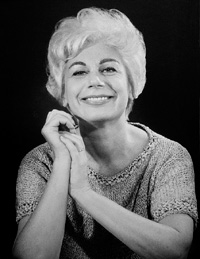
"You have to understand what Toronto was like in the 30s," Marcia's friend, Gerry Shumer once told me. "Most apartments wouldn't rent to Jews. Eatons wouldn't hire Jews. Resorts had signs that said 'Restricted Patronage.' If you were a woman and a Jew, you had two strikes against you. You had to develop some way of coping."
My mother didn't have far to look for a model of how to cope. Her mother, Selma, was a ramrod-straight, Toronto bourgeoise, who had left her immigrant, garment-factory life when she married a successful Toronto furrier, A.J. Levitt. She sent her only daughter - my mother had four brothers - to Normal Model School. Selma drilled her on manners and deportment. A.J., on the other hand, delighted in Marci's high spirits and artistic bent. Marci and he planned that, when she was old enough, she would go to New York to learn clothing design. When at 16, Marci's portfolio won her early acceptance to the Ontario College of Art, A.J. convinced Selma to let her leave high school for art college. The Group of Seven were her teachers. However A.J. died suddenly in 1928 and Selma pulled Marci out of OCA. She enrolled her in secretarial school.
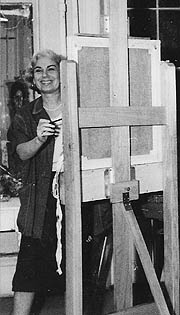
"Even in the 1960s, when I was having shows and selling my paintings," Marcia recalled, "Mother would phone and say 'What are you doing?' If I told her I was painting, she would get very annoyed. After awhile, I got smart and I'd tell her I was doing housework. She'd say, 'That's a good girl.'" Marci's dreams of clothing design died with A.J. For Selma, it was unseemly - too close to garment work. She got Marci a job at Simpson's, where she worked for a decade, eventually arranging window displays. In 1939 she married Dave Bossin, a confirmed bachelor of 34, and a prominent figure in the gambling business. Surprisingly, Selma approved. I was born in 1946.
Perhaps to counter the doldrums of 50s-style wife-and-motherhood, Marcia took up painting again. Within a few years, her canvasses were in the Shaw-Remington and other Toronto galleries. "Marcia's paintings have an inner and glowing beauty," wrote painter Jack Pollock, when he presented her work in 1963. Marcia's paintings are remarkable, and that she made a career of them is just as remarkable, considering the obstacles a woman in the Canadian art world faced in the 50s and 60s. But you would never know it from her. She continued to make out that she was just doing housework.
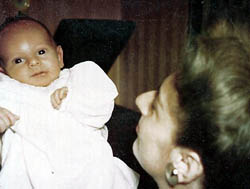
Except with her "nieces." Over a dozen years, Marcia painted portraits of the daughters of family and friends. In retrospect, it was a concerted, subversive effort. While the girls posed, they would discuss life and love. "During those hours and hours," recalls Wendy Bederman, "she told me about her life and I told her about mine - which, believe me, was not very interesting. But hers! She would tell me about Spain, and by the end of the afternoon, I could see it as if I had been there. One time, I asked her why she never remarried - a shocking thing in my youth. She told me, 'I can have a man in my bed when I want. Why should I do his laundry?'" Those sittings were a two-fold gift to the nieces: Marcia gave them a portrait of themselves, and a glimpse of who they could be.
My mother always looked and acted ten years younger than she was. It was only in her 90s that 20 years of living with diabetes caught up to her. Reluctantly, she left the Toronto house where she had lived for nearly 60 years, and moved, with her care-giver Claudia Scacchi, into a little house on Gabriola Island, just up the hill from me. Very few diabetics live as long as Marcia did. For the few who do, the years of fluctuating blood sugars gradually wear out the small blood vessels that nourish the brain. In Marcia's case, this gave her ever increasing difficulty speaking, putting thoughts together and remembering. Eventually her speech became fitful and nearly monosyllabic. Yet she made a new set of friends among the care-givers and others she met on Gabriola. Frankly, it baffled me. "She was just so good natured," said Ingrid Witvoet. "I'd come in and she'd smile this big, warm smile."
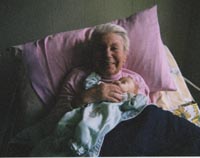
Barbara Ebbeson, a Gabriola artist and musician, took a great shine to her. "She was so positive and happy. She could sing Victor Herbert, even if she couldn't speak. She was still so clearly an artist, even if she couldn't paint as she had. Sometimes we'd think she was off in never-never-land, and then someone would say something about sex and Marci would perk right up."
Joan Granatstein, one of her nieces, remembers Marcia advising her, "You can never have too many friends." It was a philosophy she lived, and continued to embody, as her other abilities weakened. Until a week before her death, it was clear that, for all the things she could not do, or say, or remember, or understand, she was enjoying the things she could. Then one morning, she lost that spark, probably to a stroke. It gave us all, herself included, a few days to accept that this would be the end. She stopped wanting to eat, and we stopped pestering her to. One afternoon, a day or so before she died, she and I said our goodbyes, though hers was silent. But it was clear as a bell. A day later, on January 30, as I held her hand, she gently stopped breathing. It was a graceful passing. She was elegant to the end.
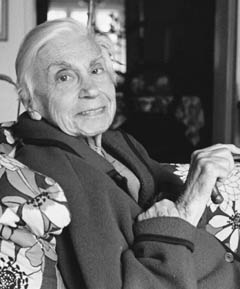
For years, when Marcia lived in Toronto, Hau Nguyen cut her hair. He told me, "Secretly (she did not know this), my schedule was booked solid each minute. But with her, I reserved plenty of time, usually two hours, so we could share a sandwich - which I would always bring - and stories about her life and mine. One day she asked me, 'Do you want to love, or do you want to be loved?' I said, 'I want to love.' She smiled and agreed. That day she was wearing stunning leather pants, a white decollete chemise, a red beret and red boots."
For me, Marcia's wisdom was filtered through a son's spotty willingness to listen to his mother. Later in our lives, I listened acutely. "I loved anything that was beautiful," she told me, at 80-something. "Beautiful music. People who were beautiful. Beauty just turned me on." And she added, "Nothing was as satisfying as the painting. Other than a good lover."
Marcia's Art
Some of Marcia's paintings are available. I have also made cards from some of her work. Contact
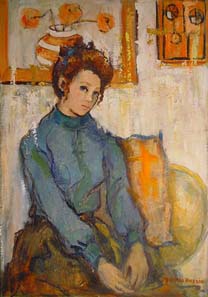
Marcia's career as an artist spanned 70 years, until failing eyesight forced her to lay down her brushes at 86.
In the late 1920s, she was a student of the Group of Seven. Franz Johnson was a particular mentor. She recalled her first encounter with him, at the then-fledgling Ontario College of Art. "I found an easel and watched as the model entered, walked to the stage and threw off her robe. I was so embarrassed that I spent the entire class working with my back to the model. Finally, Mr. Johnson came by and said, "'Mees Levitt (Mom's maiden name), if you do not wish to observe zee model, zat is your choice. But you must know, zey are hround, not square!"
Marcia went on to be a member of the Ontario Society of Artists, a founder of the Toronto Outdoor Art Exhibit and a founder or member of a half-dozen other Canadian artists' societies. She had many exhibitions and commissions, particularly through the 1960s. Her paintings hang in collections across North America and in Europe.
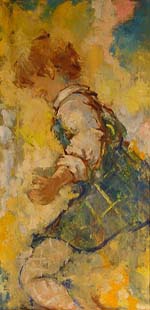
"Marcia Bossin mastered the painterly approach to portraiture she was taught in the 20s and 30s," says Joyce Young, Associate of the Ontario College of Art, "which is no small achievement. But to this she added passion, vigorous brush work and bold colour choices."
Primarily working in oil, Marci's canvases mixed a high standard of craftsmanship with playfulness and exuberant colours. "You can get a likeness with three lines," she would say, "but a good painting tells a story. In fact it hints at many stories. It changes as the light changes. A portrait should look a little different every time you see it, just like the person does."
Whether she painted nudes, still-life studies, children or landscapes, said artist, Jack Pollock, "Marcia's paintings have an inner and glowing beauty, a sincere and personal charm."
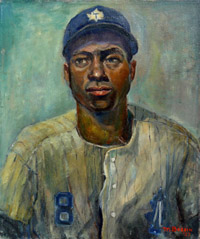
"Painting isn't mechanical," Marcia insisted. "The best work is always an accident. It is never something you can repeat. Sometimes I will add a colour and think, 'That's what I've been after,' and change everything else in the painting. That's what I love. That's what would get me up in the middle of the night to go and look again, just to see if I still saw what I saw before."
Mom's portrait of Sam Jethroe, one of the first black players to integrate the major leagues, inspired my song, Daddy Was a Ballplayer. The song garnered Stringband its first national attention, and led to my own career in the arts.
Other views
If you have a story about Marcia to share, send it to bob@bossin.com.
Although it has been years, Marcia stayed with me as a vibrant person who seized the moment. I recall her talking about going to the Royal Alex in her fur coat, and replying to a society photographer who asked who she was: "I'm Marcia Bossin!" Indeed, that's the way to go through life, with style and pride and a sense of self. - Susan Helwig

I thought it best to leave this candid view of Marcia anonymous, at least for the moment.
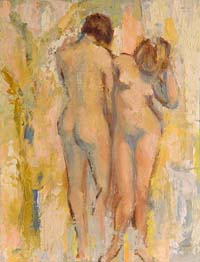
From as long ago as I can remember, Marci was there. While my mother was yelling and X was being a princess, Marci was kool. I mean KOOL to a 10, 12, 14, 16 year old. No fuss, always going somewhere that seemed very glamorous. Never worrying whether she was alone or with a travelling partner.
When I asked her why she never remarried - a shocking thing in my youth - she told me "I can have a man in my bed when I want, but why would I want to wash his dirty clothes." Made sense to me. At 16 Marci painted me nude. A double-image nude with me facing a full-length mirror. During those hours and hours and hours - which by the way, I loved - we talked non-stop. She told me about her life and I told her about mine - which believe me was not very interesting...but hers was to me! She indicated that she had raised Bob much differently than our parents raised us. She would say that kids should raise themselves - sort of do their own thing and have there own experiences... not be stopped by the parent unless they were in harms way - physically, not emotionally. She felt we would all find our own way eventually. She seemed to accept things that I think I never could. She did it with great grace as with everything in her life. When her grand-daughter was born, I will never forget her saying "Lets face it - I will probably never see her grown up." I knew then that the logic was flawless, but she was accepting of this - all of it.
It is hard for me to remember in detail all the things we spoke of, she shaped me in many ways. Her mind was always working and open to anything. I remember her telling me of her first trip to Spain - I think. By the end of that afternoon, I could see where she stayed as if I had been there. When I was about 17 - 18 she told me it was ok to sleep with people - never said men or women. She just bowled me over! She had an openness about her that was fair-minded and giving. When I told X about her passing, he said "Now that REALLY is the end of an era". For me that is certainly true.

Hau Nguyen was Marcia's hairdresser for years, though it was obvious they were also dear friends, despite the 40 - 50 year difference in age.

I have wonderful memories of Marcia's visits. Secretly (she did not know) my schedule was booked solid each minute. But with her, I reserved plenty of time so we could have some privacy, some time to share a bite and the story about her life and mine. We shared our sandwiches together, which usually I had prepared a day before, knowing that she was coming. And a lot of stories about love.
One day she asked me, "Do you want to love, or do you want to be loved?" I said "I want to love". She smiled and agreed. That day she was wearing stunning leather pants, a white decollete chemise, red beret and red boots. That will tell you about her passion, her love, her style. I always adored your Mum. We had such a great time each visit, which lasted usually 2 hours!
She once said to me, "Of course we all do need love. At my age, it doesn't matter whether it be a man or a woman."
I still have a small treasure from her, those little spoons with whimsical handles which may be odd to somebody else but to me they represent the whole world of imagination.
I am looking forward to attending the Memorial service if you'll let me know the address and the time, because Marcia will be alive again to all of us, with her love and her beauty.
- Hau Nguyen

Marci had an unusually sharp perception of the people she knew. With me, at every stage of my life, she needled me to have the courage to march to my own drummer.
She also used to say, "You can never have too many friends." Accordingly, she acted kindly to everyone. I have a little story about this. Marc and I were visiting an old woman. In the bay window of her apartment she had some ragtag plants. Marci told her how pretty they were. The woman came to life and thanked her.
When we left I said, "Those plants were very sorry looking." Marci said, "Of course, but I could tell she loved them."
- Joan Granatstein

My gorgeous Aunt Marcie, she was one in a million! I spent the summer of my 12th year with her and it was like living with Auntie Mame. She excited me, she perplexed me. Where DID she come from, this auntie who was so different from all my other aunties? We spent many hours in Marcie's studio while she tried to paint me. It was frustrating for her; she kept saying she couldn't capture me the way she wanted. But it was great for me as I got to spend so many hours with her while she painted/repainted, listening to her stories and laughing like I'd never laughed before. We also had tea in the garden, tea in the living room, tea in the kitchen.... I remember Marcie's story of how she turned gray at such an early age (I think it was 21); I thought she was terribly glamorous with gray hair, while my Mother and her friends dyed their hair (how boring!)... While staying with your Mom and Dad, I met a boy (also 12 years old) and we had a "crush" on each other. Marci wasn't horrified, nor did she treat it like puppy love, she honored how I felt and kept my secret from your Dad (and from my Dad and Mom who would have been absolutely horrified!) Marcie also explained to me "why" the girls hung around Uncle Hye when he and I went to the beach together. At 12, I didn't know anything about how the "birds" go after the "bees."
- Pam Arthur

To get in touch click here.